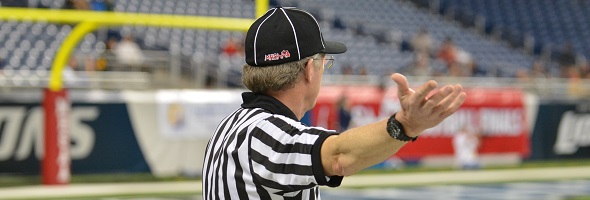
Be the Referee: Intentional Grounding
October 15, 2015
This week, MHSAA assistant director Mark Uyl explains the difference between high school and college/pro rules when it comes to intentional grounding.
Be The Referee is a series of short messages designed to help educate people on the rules of different sports, to help them better understand the art of officiating, and to recruit officials.
Below is this week's segment - Make the Call: Intentional Grounding - Listen
A QB is rolling out wide toward the sideline and is being chased by two large defenders. To avoid a certain sack, the QB throws the ball away deep down the field where no offensive receiver is even in the same zip code of where the ball hits the ground.
What’s the call?
Under high school rules, this is intentional grounding as there always has to be a receiver in the general area of the pass. At the college and pro levels, all the QB has to do is throw the ball beyond the line of scrimmage if he has scrambled outside of the tackle box. When at your next game, know this important difference when it comes to intentional grounding.

Be the Referee: Catch or No Catch
By
Brent Rice
MHSAA Assistant Director
September 16, 2021
Be The Referee is a series of short messages designed to help educate people on the rules of different sports, to help them better understand the art of officiating, and to recruit officials.
Below is this week's segment – Catch or No Catch - Listen
Catch … or no catch. It’s a decision that must be made in a split second and can be one of the most difficult decisions a football official has to make – especially one along the sidelines.
In high school, for a catch to be considered complete the receiver must:
Have possession and control of the ball AND
One foot or other body part must first come down in bounds.
This means that if you are forced out of bounds while in the air and with possession of the ball, it is NOT a catch. A defender can legally knock an airborne receiver out of bounds to prevent a completion. The receiver has to get one foot – or other body part – down in bounds for it to be ruled a complete catch.
Previous editions
Sept. 9: Intentional Grounding – Listen
Sept. 2: Pass Interference – Listen
Aug. 26: Protocols and Mechanics – Listen

